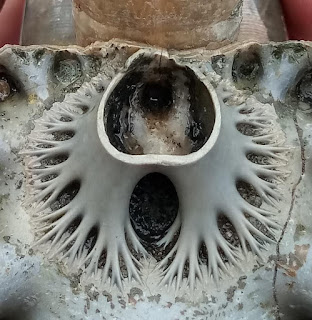The fossil specimens include individuals with enlarged breeding teeth and worn caudal fins. It is likely that these salmon acted very similar to their modern counterparts with males partaking in competitive and sneaky tactics to gain access to the sexiest (large and red) females who were ready to mate. These ancient salmon had migrated, dug their nests, spawned and defended their eggs prior to their death. For now, we're referring to the species found here as Oncorhynchus nerka, as they have many of the characteristics of sockeye salmon, but also several minor traits of the Pink Salmon, Oncorhynchus gorbuscha.
 |
| Oncorhynchus nerka, Pleistocene Sockeye Salmon |
It looks as though this population diverged from the original species about one million years ago, possibly when the salmon were deposited at the head of a proglacial lake impounded by the Salmon Springs advancement of a great glacier known as the Puget lobe of the Cordilleran Ice Sheet.
After the ice began melting and retreating north, the landscape slowly changed — both the land and sea levels rising — and great freshwater lakes forming in the lowlands filled with glacial waters from the melting ice. The sea levels rose quite considerably, about one and a half centimetres per year between 18,000 and 13,000 years ago. The isostatic rebound (rising) of the land rose even higher with an elevation gain of about ten centimetres per year from 16,000 to 12,500 years ago.
Around 14,900 years ago, sea levels had risen to a point where the salty waters of Puget Sound began to slowly fill the lowlands. Both the land and sea continued to rise and by 5,000 years ago, the sea level was about just over 3 meters lower than it is today. The years following were an interesting time in the geologic history of the Pacific Northwest. The geology of the South Fork Skokomish River continued to shift, undergoing a complicated series of glacial damming and river diversions after these salmon remains were deposited.
Today, we find their remains near the head of a former glacial lake at an elevation of 115 metres on land owned by the Green Diamond Company. The first fossil specimens were found back in 2001 by locals fishing for trout along the South Fork Skokomish River.
Upon seeing the fossil specimens, Smith teamed up with David Montgomery of the University of Washington, Seattle, along with N. Phil Peterson and Bruce Crowley, a Late Oligocene Mysticete specialist from the Burke Museum, to complete fieldwork and author a paper.
The fossil specimen you see here is housed in the Burke Museum collection. They opened the doors to their new building and exhibitions in the Fall of 2019. These photos are by the deeply awesome John Fam from a trip to see the newly opened exhibits this year. If you fancy a visit to the Burke Museum, check out their website here: https://www.burkemuseum.org/.
David B. Williams did up a nice piece on historylink.org on the Salmon of the Puget lowland. You can find his work here: https://www.historylink.org/File/20263
If you'd like to read more of the papers on the topic, check out:
- Smith, G., Montgomery, D., Peterson, N., and Crowley, B. (2007). Spawning sockeye salmon fossils in Pleistocene lake beds of Skokomish Valley, Washington. Quaternary Research, 68(2), 227-238. doi:10.1016/j.yqres.2007.03.007.
- Easterbrook, D.J., Briggs, N.D., Westgate, J.A., and Gorton, M.P. (1981). Age of the Salmon Springs Glaciation in Washington. Geology 9, 87–93.
- Hikita, T. (1962). Ecological and morphological studies of the genus Oncorhynchus (Salmonidae) with particular consideration on phylogeny. Scientific Reports of the Hokkaido Salmon Hatchery 17, 1–97.
If you fancy a read of Crowley's work on Late Oligocene Mysticete from Washington State, you can check out: Crowley, B., & Barnes, L. (1996). A New Late Oligocene Mysticete from Washington State. The Paleontological Society Special Publications, 8, 90-90. doi:10.1017/S2475262200000927










.png)

%20(7).png)




















